Different Types of Yarn: Explained
There are many types of yarn that you can choose from when you are crafting with yarn, be it crocheting, knitting & more.
Yarn can be made of different fibers, weights and textures, as shown below.
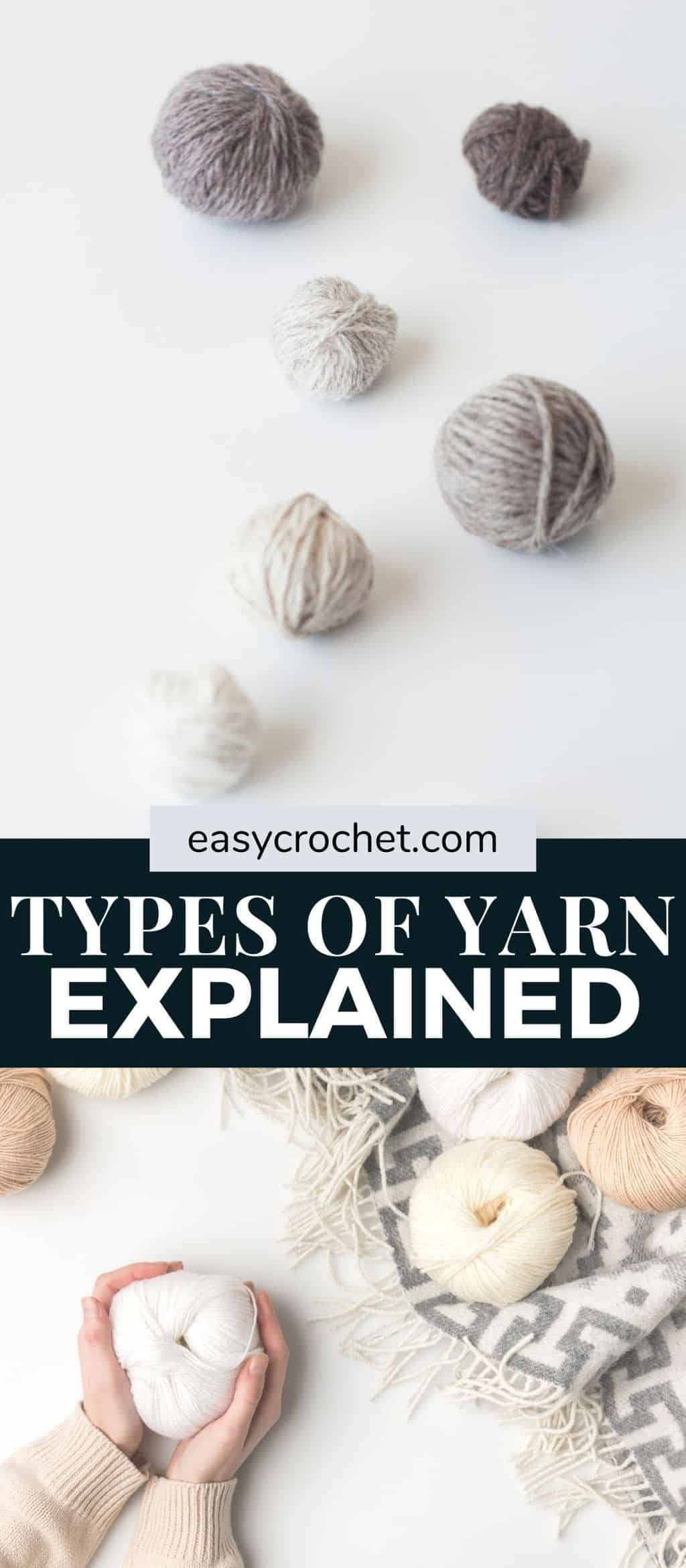
When you are crocheting a project, it is essential to make sure you are picking the right yarn for the type of project you are making.
For example, if you crochet an acrylic potholder, it will melt once it comes in contact with heat, so you will need to use 100% cotton instead, so it will hold up to the heat.
This is just one instance of why knowing about all the various types of yarn is important before starting a knit or crochet yarn project.
All yarns are a different since they can be spun and mixed with different properties to create a unique blend as well as different weights of yarn.
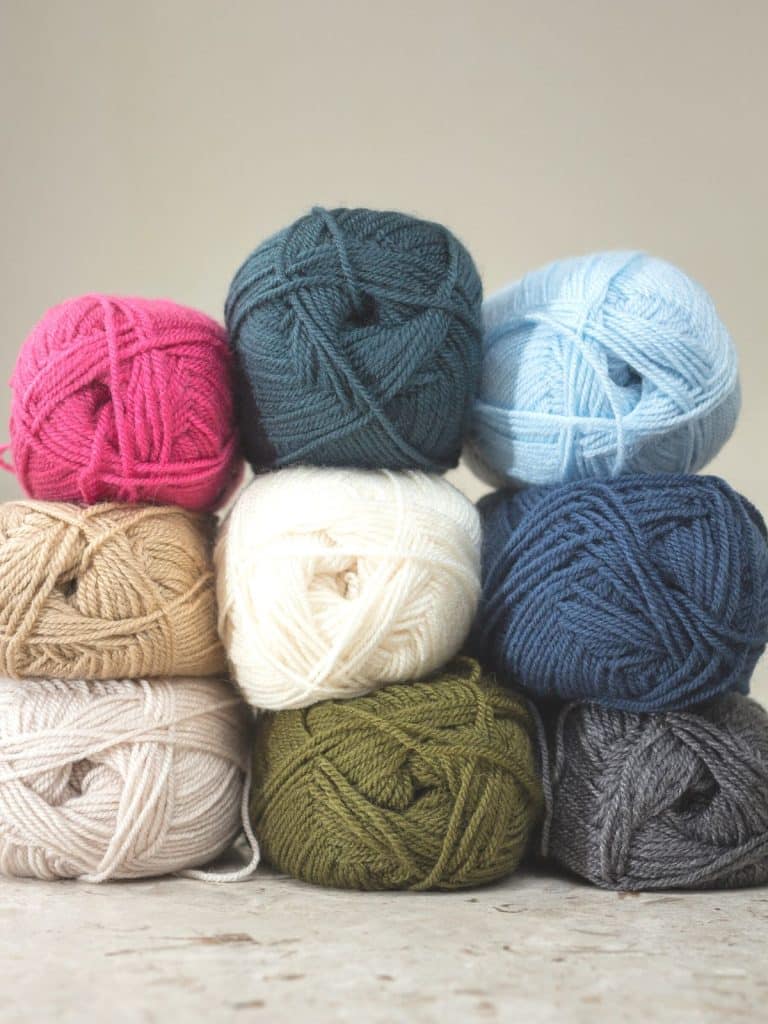
Scroll on down to learn about the types of fibers yarn can be made in such as animal, plant based and acrylics.
You can look at the list below as well as a more detailed explanation following.
What are the Types of Yarn Fibers?
Most types of yarn fibers can be broken down into two categories: natural and synthetic.
- Natural fibers come from animals such as sheep or alpacas or are plant derived, such as cotton or bamboo. Different still, silk yarn is also a natural fiber yarn, but instead comes from the silkworm. Yarn made from animal fiber typically has much stricter care instructions.
- Synthetic fibers are those that are made up of various plastics. These plastics can range from the very common acrylic, to polyester, rayon or nylon. Synthetic yarns are easy to care for, including hassle-free washing and drying requirements.
Note: There are also blended yarns that include a bit of both natural and manufactured. One of the more commonly found blended yarns is the acrylic & cotton blend. How much of each is up to the brand and manufacturer of the yarn, but they can range anywhere from 90/10 acrylic or 90/10 cotton.
Blended yarns are popular because they get to take advantage of each of the qualities of the different materials. You will find other blended yarns such as wool mixed with acrylic and more.
Natural Fiber Yarn Types
| Advantages of Wool | Disadvantages of Wool |
|---|---|
| Durable: Wool yarn is known for its durability and can last for a long time. | Can be expensive: Wool yarn can be more expensive compared to other types of yarn. |
| Warmth: Wool yarn is great for making warm and cozy garments and accessories. | Allergic reactions: Some people may be allergic to wool, causing skin irritation or other allergic reactions. |
| Softness: Wool yarn can be very soft, making it comfortable to wear. | Shrinkage: Wool yarn can shrink if it’s not handled properly, such as being washed in hot water or put in the dryer. |
| Elasticity: Wool yarn has a natural elasticity, which means it can stretch and then return to its original shape. | Requires special care: Wool yarn requires special care when washing and storing to ensure it maintains its quality and shape. |
| Breathability: Wool yarn is breathable and can wick away moisture, making it great for active wear. | Felting: Wool yarn can easily felt if it’s exposed to hot water or agitation, which can make it difficult to work with. |
| Advantages of Alpaca | Disadvantages of Alpaca |
|---|---|
| Softness: Alpaca yarn is known for its softness and is often compared to cashmere. | Can be expensive: Alpaca yarn can be more expensive compared to other types of yarn. |
| Warmth: Alpaca yarn is warmer than wool and can be used to make cozy garments and accessories. | Shedding: Alpaca yarn may shed or pill more easily compared to other types of yarn. |
| Hypoallergenic: Alpaca yarn is hypoallergenic and is less likely to cause allergic reactions compared to other types of yarn. | Lack of elasticity: Alpaca yarn doesn’t have as much elasticity as wool, which can make it difficult to work with for certain projects. |
| Advantages of Bamboo | Disadvantages of Bamboo |
|---|---|
| Softness: Bamboo yarn is soft and silky, and often compared to cashmere or silk. | Limited elasticity: Bamboo yarn doesn’t have as much elasticity as wool, which can make it difficult to work with for certain projects. |
| Breathability: Bamboo yarn is breathable and moisture-wicking, making it great for warm weather garments and accessories. | Can be expensive: Bamboo yarn can be more expensive compared to other types of yarn. |
| Sustainability: Bamboo is a sustainable material, and bamboo yarn is eco-friendly and biodegradable. | Limited availability: Bamboo yarn may not be as readily available as other types of yarn. |
| Anti-bacterial: Bamboo yarn is naturally anti-bacterial and odor-resistant, making it great for socks and other garments that may be worn for extended periods of time. | May require special care: Bamboo yarn may require special care, such as hand washing and air-drying, to maintain its softness and shape. |
| Advantages of Cotton | Disadvantages of Cotton |
|---|---|
| Softness: Cotton yarn is soft and gentle on the skin. | Lack of elasticity: Cotton yarn doesn’t have as much elasticity as wool, which can make it difficult to work with for certain projects. |
| Breathability: Cotton yarn is breathable and can wick away moisture, making it great for warm weather garments and accessories. | Shrinkage: Cotton yarn can shrink if it’s not handled properly, such as being washed in hot water or put in the dryer. |
| Durability: Cotton yarn is durable and can last for a long time. | Wrinkles easily: Cotton yarn has a tendency to wrinkle easily and may require ironing or steaming to maintain its appearance. |
| Hypoallergenic: Cotton yarn is hypoallergenic and is less likely to cause allergic reactions compared to other types of yarn. | Not as warm: Cotton yarn isn’t as warm as wool or alpaca yarn, which may not be suitable for colder weather garments and accessories. |
Synthetic Yarn Types (Man-Made Yarn Fibers)
| Advantages of Acrylic | Disadvantages of Acrylic |
|---|---|
| Affordability: Acrylic yarn is often more affordable than other types of yarn, making it a great option for beginners or those on a budget. | Not as breathable: Acrylic yarn is not as breathable as natural fibers like cotton or wool. |
| Durability: Acrylic yarn is very durable and can withstand wear and tear, making it great for frequently used items like blankets and scarves. | Can be less soft: Acrylic yarn may be less soft than natural fibers like cotton or wool, though this can vary by brand and type. |
| Low-maintenance: Acrylic yarn is easy to care for and can be machine washed and dried without shrinking or felting. | Not as warm: Acrylic yarn is not as warm as natural fibers like wool or alpaca, which may not be suitable for colder weather garments and accessories. |
| Lightweight: Acrylic yarn is lightweight and comfortable to wear. | Not eco-friendly: Acrylic yarn is made from synthetic materials and is not biodegradable, which may not be ideal for environmentally conscious crafters. |
| Wide range of colors: Acrylic yarn comes in a wide range of colors, making it easy to find the perfect shade for any project. | Can be prone to pilling: Acrylic yarn may be prone to pilling, especially with frequent use or washing. |
| Advantages of Faux Fur | Disadvantages of Faux Fur |
|---|---|
| Cruelty-free: Faux fur yarn is made from synthetic materials and does not require the use of animal fur, making it a cruelty-free alternative to real fur yarn. | May shed: Faux fur yarn may shed fibers, which can be messy and require extra care during knitting or crocheting. |
| Softness: Faux fur yarn is often very soft and can add a cozy and luxurious feel to a finished project. | Can be challenging to work with: Faux fur yarn can be difficult to work with due to its texture. |
| Variety of colors: Faux fur yarn comes in a variety of colors and textures, making it easy to find the perfect option for a specific project. | Can be hot: Faux fur yarn can be warm to wear and may not be suitable for projects that will be worn in warmer weather. |
Note: Keep in mind, depending on brand, yarn weight and other factors, your results may be different when using the above yarns.
Types of Yarn for Crochet
You can crochet with any type of yarn. The type of yarn you choose to crochet your project with is determined by what each type of yarn is good for, which was described above in great detail.
I like to use 100% cotton or an acrylic blend when crocheting most of my projects. Acrylic blends are fantastic for blankets, while cotton (or cotton blend) yarns are typically reserved for projects such as hotpads or washcloths.
If you are new to crocheting, I would suggest buying an acrylic blend yarn that is either a 4 (medium) or 5 (bulky) weight yarn. Yarn of this size (which I get into more detail below), is easier to hold and see the stitches with.
Pro-tip: Don’t crochet with black or very dark yarn if you are just beginning… it is very hard to see the individual stitches and you will become frustrated almost immediately!
Types of Yarn Weights
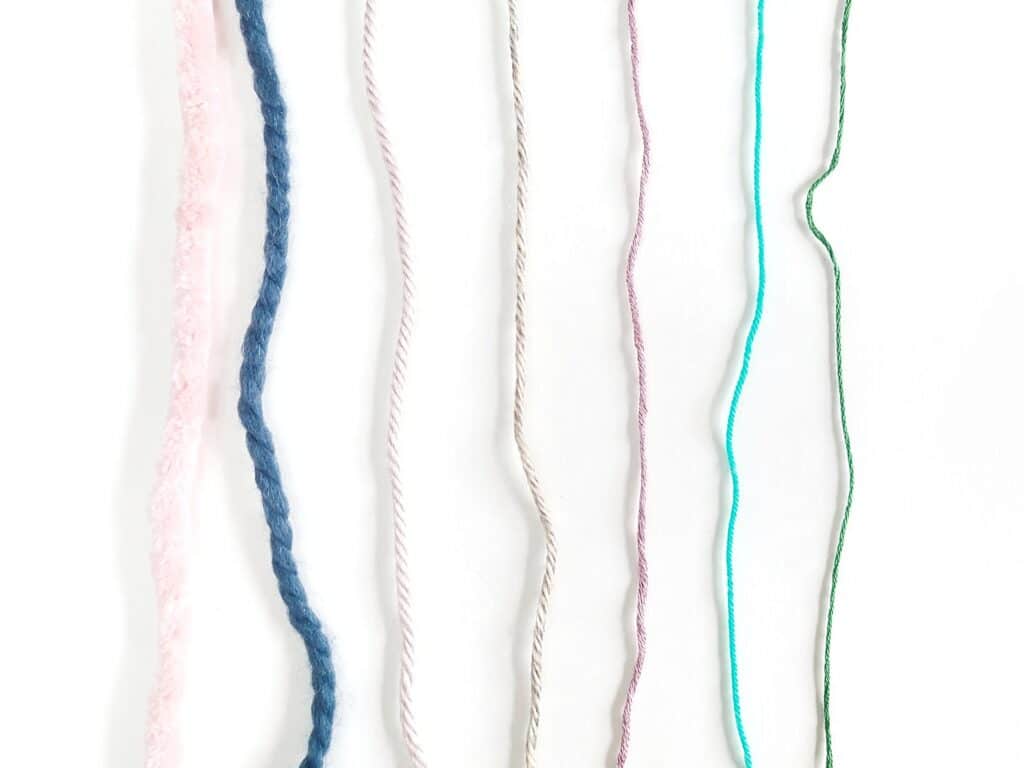
Yarn thickness is used to determine the weight of the yarn. Use the yarn weight chart below as a guide to determine how and when you should use each type of yarn.
The yarn weights explained below are based on the CYC Standard weight System.
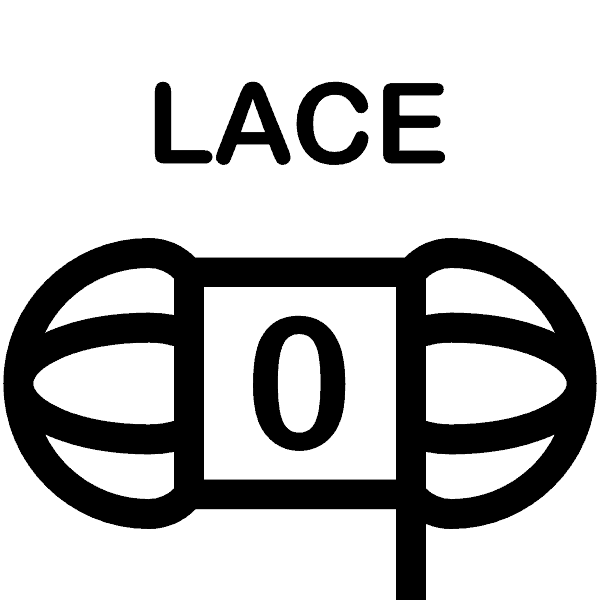
Weight #0 or Lace includes yarn type fingering 10-count crochet thread. This weight of yarn is usually crocheted using the US hook size of 6/7/8 (steel) and B-1 of regular. The metric equivalent is 1.6-1.4 mm for steel and the regular metric hook size of 2.25 mm.
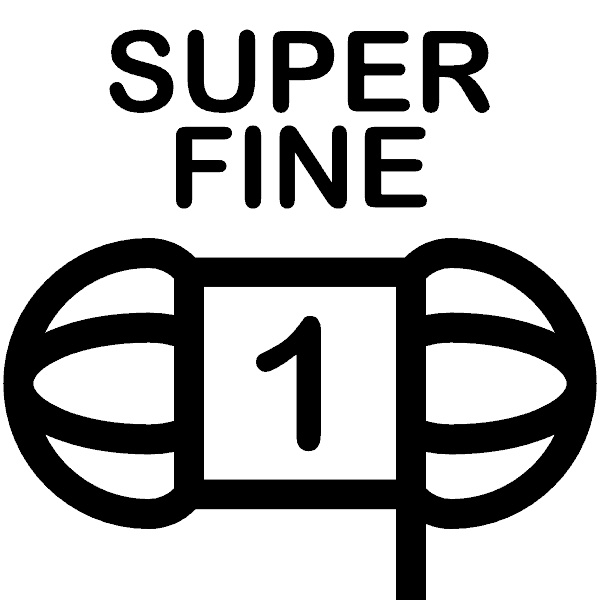
Weight #1 or Super Fine includes yarn types of sock, fingering, and baby. This weight of yarn is typically crocheted using the US hook sizes of B-1 to E-4 and the metric sizes of 2.25 – 3.5 mm.

Weight #2 or Fine includes yarn types of sport and baby. This weight of yarn is typically crocheted using the US hook sizes of E-4 to 7 and the metric sizes of 3.5 – 4.5 mm.

Weight #3 or Light yarn includes the yarn types of DK and light worsted. This weight of yarn is usually crocheted using the US hook sizes of 7 to I-9 and the metric sizes of 4.5 – 5.5 mm
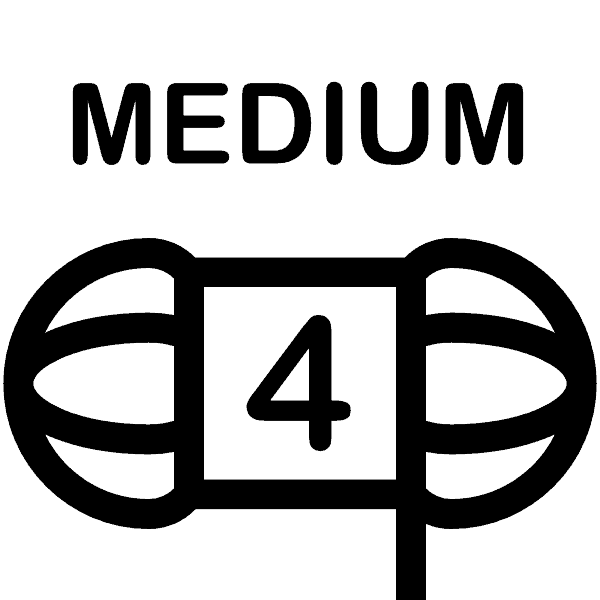
Weight #4 or Medium yarn includes the yarn types of worsted, afghan and aran. Worsted weight yarn is usually crocheted using the US hook sizes of I-9 to K-10 1/2 and the metric sizes of 5.5 – 6.5 mm.
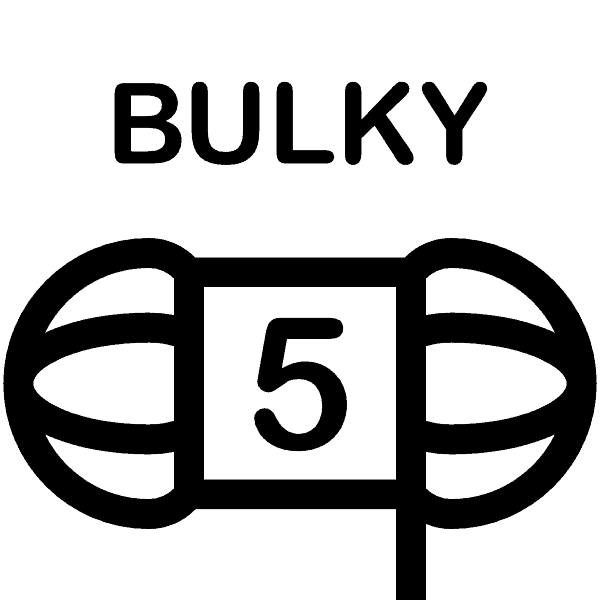
Weight #5 or Bulky yarn includes the yarn types of chunky, craft and rug. This weight of yarn is usually crocheted using the US hook sizes of K-10.5 to M-13 and the metric sizes of 6.5 to 9 mm.
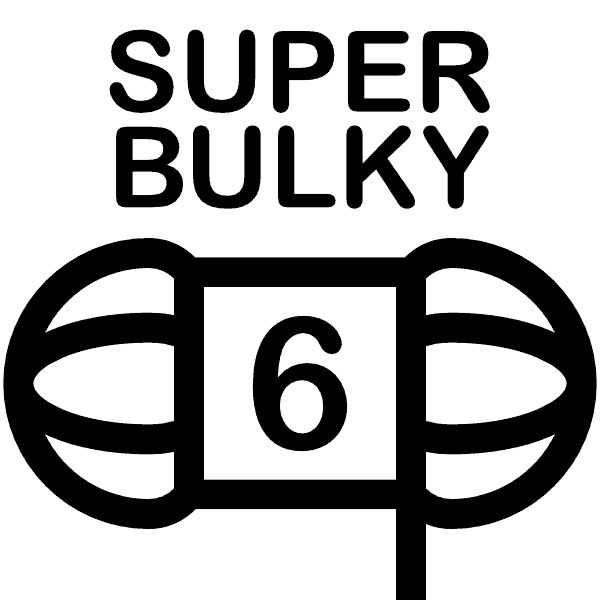
Weight #6 or Super Bulky includes the yarn types of super bulky and roving. This weight of yarn is usually crocheted using the US hook sizes of M-13 to Q and the metric sizes of 9 to 15 mm.
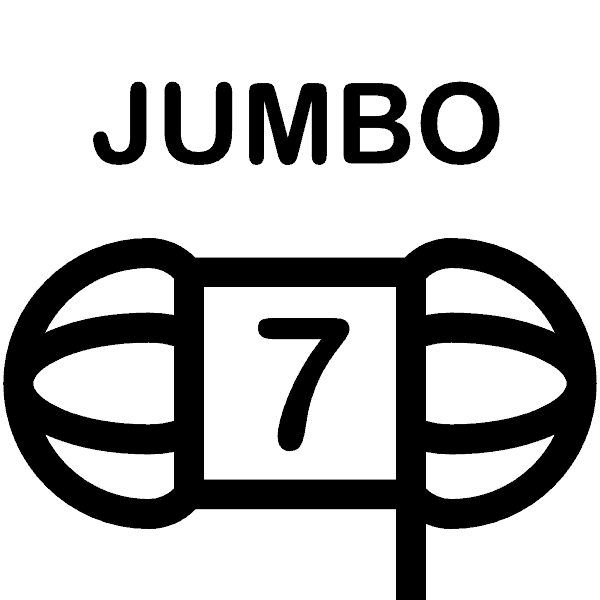
Weight #7 or Jumbo includes the yarn types of jumbo and roving. This weight of yarn is often crocheted using the US hook sizes of Q (and larger) and the metric sizes 15 mm and up.
Types of Yarn Fibers and Where to Buy Them
Learn everything you need to know about each fiber that is used to make yarn below. Then from there you can determine your favorite crochet yarn type or knit yarn type and buy the yarn that suits you best.

Merino Wool
Merino wool is from merino sheep and is one of the softest wool types. It is perfect for any type of project that will be next to the skin such as scarves, mittens, hats, and sweaters.
Two popular merino yarns are LB Collection Super wash Merino Yarn from Lion Brand and Swish Worsted from Knitpicks.
Merino wool yarn is washable, and able to withstand machine washing easily, so it’s perfect for everyday wear.
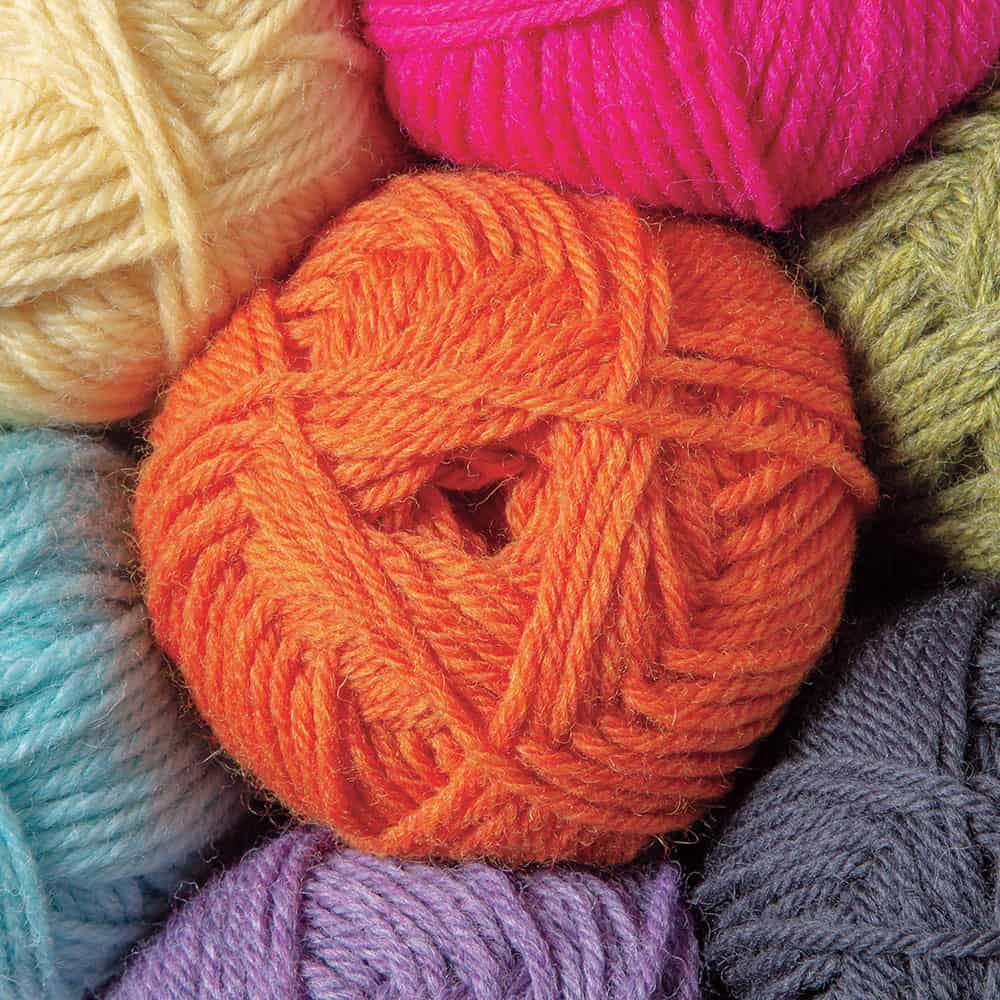
Wool
Wool yarn is made with the hair of sheep. Wool is warm as well as durable during use. It makes great sweaters, hats, scarves, and gloves. Some wool is rough or itchy at first, but gets softer with washing. Yarns made from an acrylic and wool blend are also very popular. It combines the softness of wool and the ease of use of acrylics.
Two of the more popular wool yarns are Lion Brand Fisherman’s Wool and Wool of the Andes from Knit Picks.
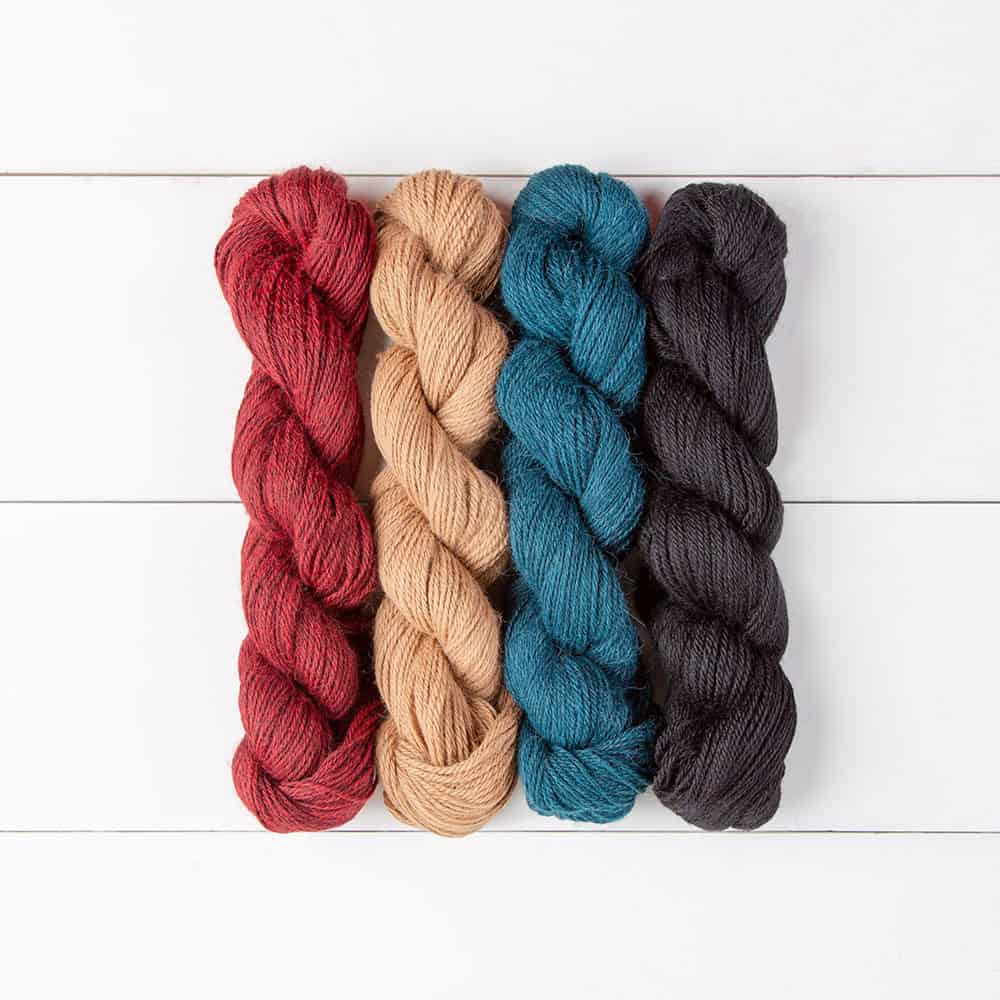
Alpaca Yarn
Alpaca yarn is made with the hair from an Alpaca. This fiber is cozy and has a luxurious feel to it which makes it perfect for anything you create that will be close to the skin. It is one of the warmest fibers available and can also be blended with other fibers easily.
Two of the more popular Alpaca yarns are Simply Alpaca from KnitPicks, and Sugar Bush Nanaimo Yarn Alpaca Blend.
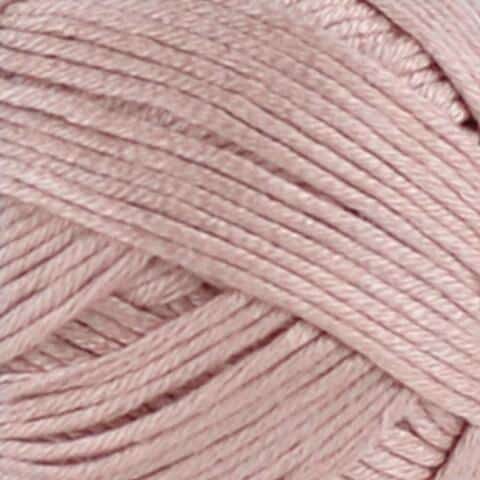
Bamboo
Bamboo yarn is made from bamboo plants and can be harvested without killing the plant which means it is eco-friendly. It is made from bamboo grass that has been extracted into cellulose and then spun into a silky smooth yarn.
This fiber is sheen and lightweight, which makes it great for Spring & Summer projects. The bamboos fibers are naturally silky soft and smooth – which makes the yarn incredibly soft for shawls, cardigans and more. It is often blended with other fibers for more texture and variety.
A favorite Bamboo yarn is Truboo Yarn from Lionbrand.

Fabric / T-Shirt
Fabric and or T-shirt yarn can be bought or made yourself using old cotton t-shirts or fabric scraps. Since this yarn will vary depending on the fabric it was made with, you will need to test out different crochet hooks to see which one would work best.
A favorite fabric yarn is Bernat Maker from Yarnspirations or if you’d prefer the DIY route take a look at this tutorial on how to make t-shirt yarn.
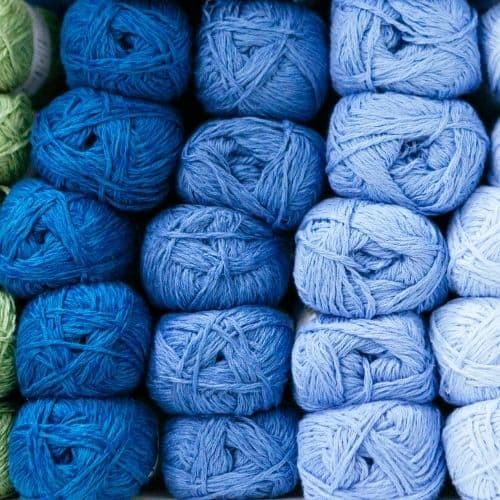
Acrylic yarn
One of the most common fibers used to create yarn is acrylic. Acrylic yarn is made with chemicals such as petroleum, which means it is a fossil fuel-based fiber. Learn more about how acrylic fiber is made and see if it is a good choice for you.
Since acrylic fiber is easily produced, it is usually inexpensive. You can find this yarn at most stores without any trouble. A few easy to find ones are Red Heart Soft and Red Heart Super Saver both of which are budget-friendly.
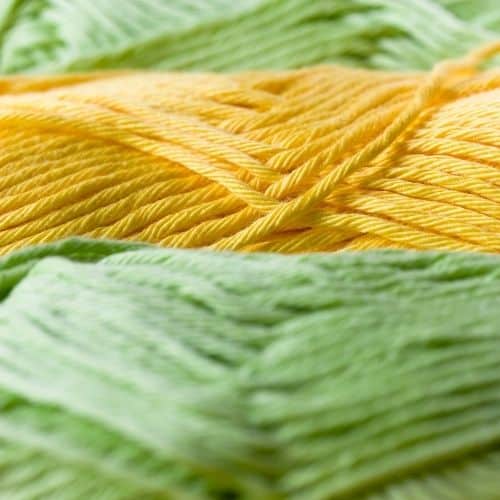
Cotton
Cotton yarn is 100% cotton and is perfect to use for washcloths, dishcloths, and anything that will require durability.
A couple of favorites of cotton yarns are 24/7 Cotton by Lion Brand and Lily Sugar’n Cream yarn by Yarnspirations, both of which are easy to find online and in store.
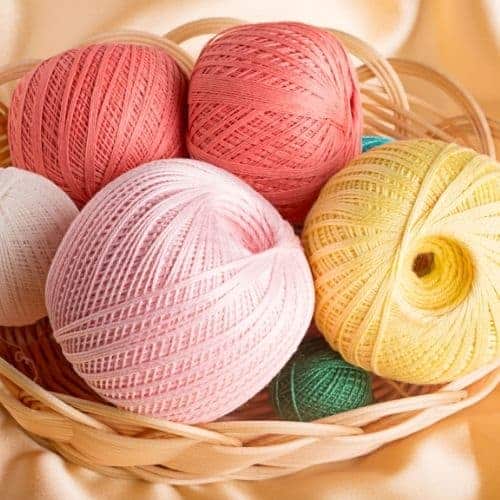
Cotton Threads
Cotton thread fiber is commonly used for lace projects and filet crochet patterns. It is a superfine 1 weight yarn that is inexpensive and can be found at most local craft stores.
A favorite cotton thread Aunt Lydia’s Classic Cotton Thread that is available from most local craft stores and online.
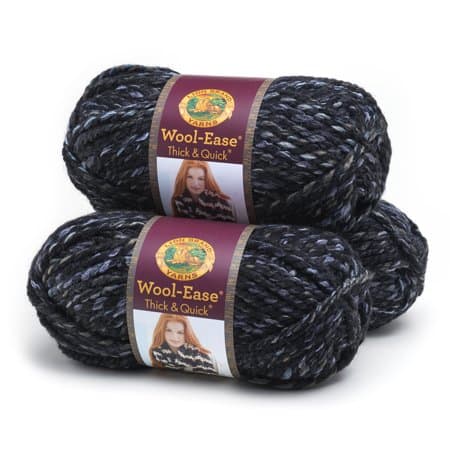
Natural & Acrylic Mixes
Natural and acrylic fiber blended yarns are great to use in projects such as socks and gloves. The blend of fiber makes it durable and easy to wash!
A good example of this type of yarn is Wool-Ease Thick & Quick from Lion Brand. It consists of a 20% wool and 80% acrylic mix.
Common Questions About Yarn Types
What is the Softest Type of Yarn?
With so many fibers to choose from, picking the softest yarn can be tough. You can find many acrylic yarns that are extremely soft such as Feels Like Butta by Lionbrand as well as natural fibers as well. Take a look at this post about the softest yarns, so you can pick your favorite yarn.
What Type of Yarn Should I use for Hot Pads?
When crocheting a hot pad, dishcloth or anything that may be exposed to high heat, you should always use a 100% cotton yarn. A cotton yarn I recommend is Lily Sugar’n Cream by Yarnspirations which is perfect to use for washcloths, dishcloths and hot pads!
Is Yarn Different for Knitting vs Crochet?
Nope! There is no difference between knitting yarn and the yarn used for crochet. Every type of fiber can be used in both hobbies.
What is Faux Fur Yarn Made of?
Faux fur yarns are made from synthetic materials, and mimic the feel of real fur without using any animal fibers. These yarns are a great ethical way to get that fur look without harming an animal in the process.
How is Self Striping Yarn Made?
Self striping yarn can be made from any fiber, and it gets its unique color from the dying process. Short sections of the yarn are dipped in vats of dye, with the next section getting a different color.
What Type of Yarn is Best for Crocheting Blankets?
A nice, sturdy plus soft yarn is important when deciding what one to use for blankets. I put together a post of some of the softest yarns for blankets that you can use to determine which yarn will be the best for your blanket project.
Now that you know why all these types of yarn exist, and the differences between them, why not make something? Check out a few of my favorite patterns below.
Free Crochet Patterns
- 30 Free Crochet Baby Blanket Patterns
- Primrose Crochet Baby Blanket
- 10 Cozy Crochet Blanket and Afghan Patterns You’ll Love
- Easy Moss Stitch Crochet Baby Blanket
- Rainbow Crochet Blanket Pattern
Free Knit Patterns

One Comment